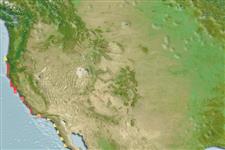>
Perciformes/Zoarcoidei (Eelpouts and pricklebacks) >
Opisthocentridae ("Rearspined fin pricklebacks")
Etymology: Kasatkia: A population in the Kuril islands; seigeli: Named for Jeffrey A. Seigel.
Eponymy: Jeffrey Alan Seigel was collections manager of the ichthyology section at the Los Angeles County Museum of Natural History. Among his published papers is: Revision of the Dalatiid Shark Genus Squaliolus: Anatomy, Systematics, Ecology (1978). (Ref. 128868), visit book page.
Environment: milieu / climate zone / depth range / distribution range
Ecologia
marino demersale; distribuzione batimetrica 6 - 26 m (Ref. 51666). Tropical
Eastern Central Pacific: California, USA.
Size / Peso / Age
Maturity: Lm ? range ? - ? cm
Max length : 8.2 cm SL maschio/sesso non determinato; (Ref. 33376)
Found near shore to depth of 26 meters (Ref. 51666).
Life cycle and mating behavior
Maturità | Riproduzione | Deposizione | Uova | Fecundity | Larve
Posner, M. and R.J. Lavenberg, 1999. Kasatkai seigeli: a new species of stichaeid (Perciformes: Stichaeidae) from California. Copeia 1999(4):1035-1040. (Ref. 33376)
IUCN Red List Status (Ref. 130435: Version 2024-2)
Threat to humans
Harmless
Human uses
Strumenti
Special reports
Download XML
Fonti Internet
Estimates based on models
Preferred temperature (Ref.
123201): 12.1 - 16.8, mean 14 °C (based on 37 cells).
Phylogenetic diversity index (Ref.
82804): PD
50 = 0.7500 [Uniqueness, from 0.5 = low to 2.0 = high].
Bayesian length-weight: a=0.00389 (0.00180 - 0.00842), b=3.12 (2.94 - 3.30), in cm total length, based on all LWR estimates for this body shape (Ref.
93245).
Trophic level (Ref.
69278): 3.2 ±0.5 se; based on size and trophs of closest relatives
Fishing Vulnerability (Ref.
59153): Low vulnerability (10 of 100).
